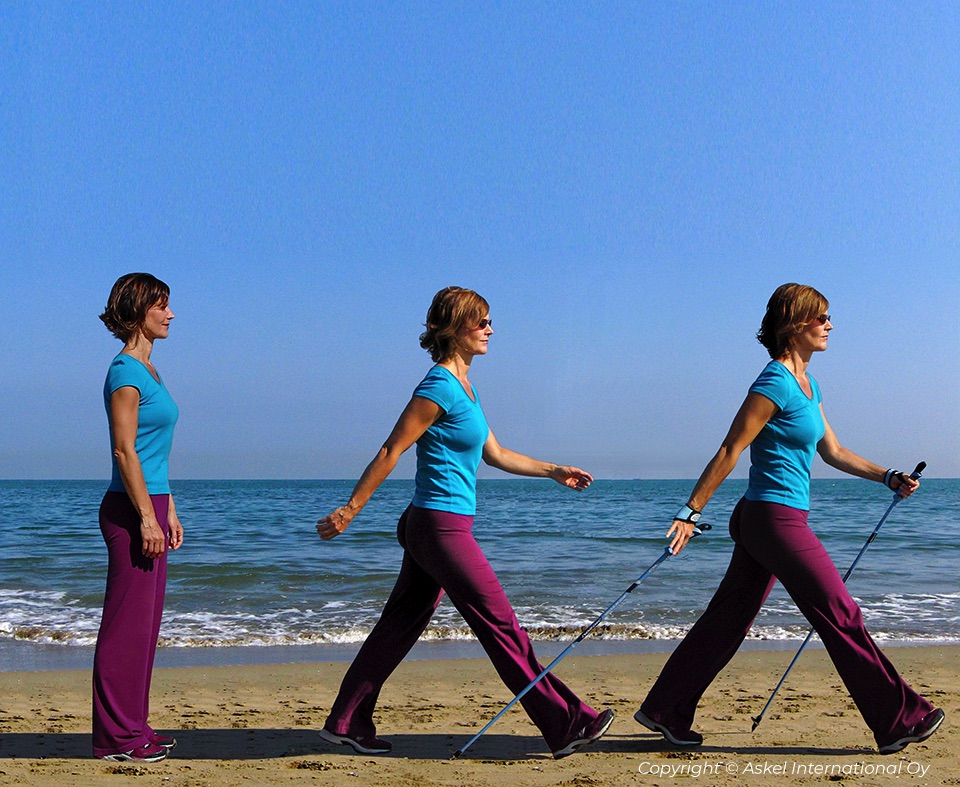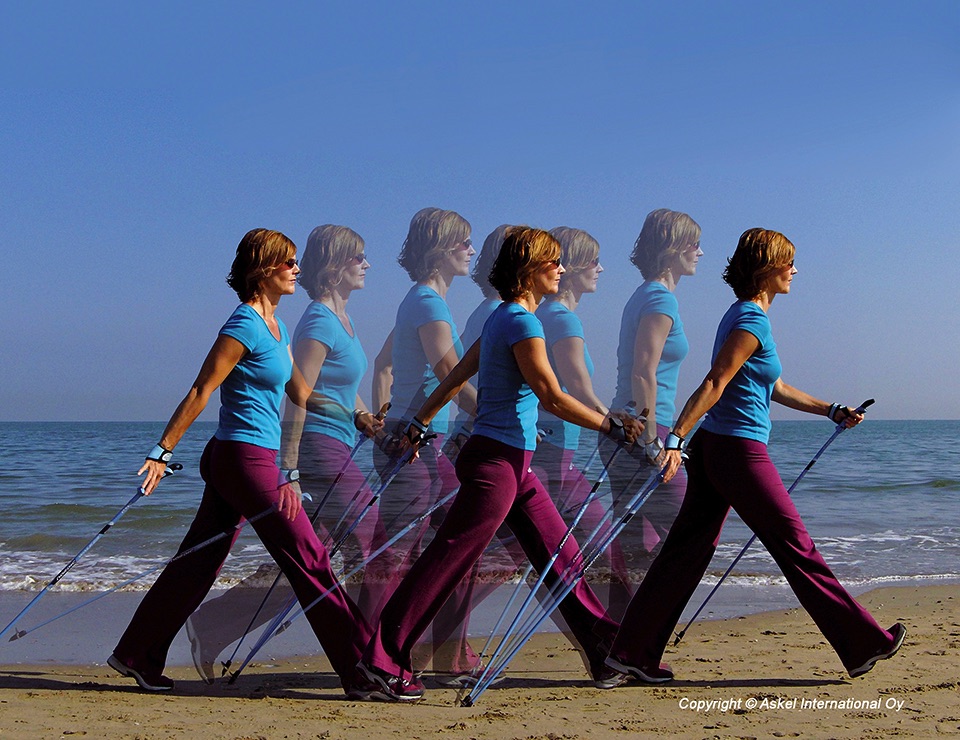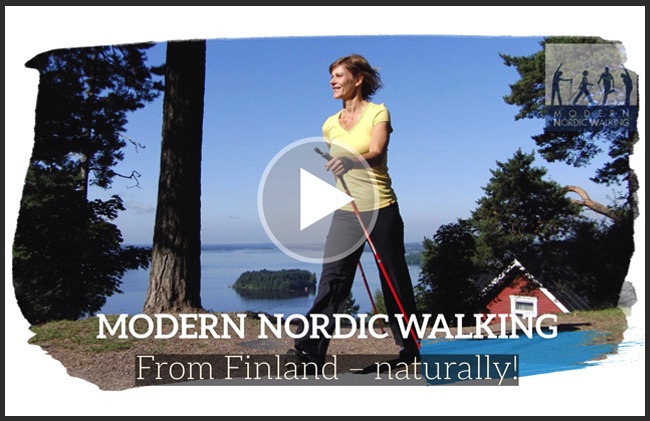
Some features of Modern Nordic Walking


STATEMENT FROM THE INTERNATIONAL COUNCIL OF NORDIC WALKING (ICNW) on February 8, 2025:
Modern Nordic Walking: Background and Updated Definition
(Published here with the permission of the International Council of Nordic Walking, ICNW)
Modern Nordic Walking: Background
Nordic Walking, the discipline launched in Finland in late 90s, has developed over the years. Different international and national organizations around the world have also launched their own versions, techniques, and descriptions of Nordic Walking.
In 2005, two Finnish professional Coaches of Nordic Walking Tiina Arrankoski and Tuomo Kettunen began the development of Modern Nordic Walking concept based on the idea of three “pillars”: posture, walking technique, and pole technique.
The founding of the International Council of Nordic Walking (ICNW), a scientific organization of Nordic Walking, gave a strong boost to further develop the Modern Nordic Walking concept and to consolidate its scientific basis. ICNW, with the help of its Scientific Advisory Board and the Educational Advisory Board, is now responsible for the continuous development of Modern Nordic Walking. ICNW periodically publishes an updated Definition of Modern Nordic Walking, which is based on the latest knowledge and results of scientific research on the human body and its movements.
The Definition of Modern Nordic Walking provided by the ICNW is the Council’s stance on the characteristics, principles, and goals of Modern Nordic Walking. The definition also includes the ICNW’s guidelines for teaching Modern Nordic Walking.
Modern Nordic Walking: Definition
1. Modern Nordic Walking is a discipline where:
● The starting point is normal, natural walking with good technique and posture, as defined and described in sports science, sports medicine, and contemporary physiotherapy.
● The active use of poles, suitable for Modern Nordic Walking, are added to normal walking in such a way that the basic characteristics of walking with good technique and posture are maintained. As a result, the range of motion of the arms while walking with poles is the same as when walking without poles at the same speed with good walking technique.
2. Based on the above, exercising and teaching Modern Nordic Walking focuses on the following areas:
● Correct posture and good body control
● Correct walking technique
● Correct pole technique
3. These three areas, the ”pillars” of Modern Nordic Walking – posture, walking technique and pole technique – are closely interconnected and follow a clear principle: the use of poles should not change the body’s natural way of moving, nor disturb the movement pattern of normal walking, its coordination or rhythm. The use of poles should support and aid the improvement of walking technique and posture. The concept of Modern Nordic Walking applies the latest knowledge and results of studies on human fascia and fascial system, and on the activation of various functional connections throughout the body responsible for its reciprocal and balanced vertical movement patterns, such as walking and running.
4. The correct use of poles offers a natural and efficient way to involve the upper body and its muscles while walking and propelling the body forward. With correct Modern Nordic Walking technique, the muscle work and the strain on the body and its various structures are distributed more evenly and appropriately.
5. The pole technique (basic technique) of Modern Nordic Walking still has some characteristics that resemble cross-country skiing, such as:
● The slanted position of the pole during the pole thrust.
● The use and control of the pole by the handle and strap. This is in part due to the fact that the handle and strap of the poles used for Modern Nordic Walking and cross-country skiing are very similar, if not identical, depending on the manufacturer.
● The active, rhythmic, and dynamic use of the poles.
6. The Modern Nordic Walking technique can be adapted to widely varying circumstances and purposes as long as the natural principles of movement are followed. These circumstances include uphill and downhill techniques on different slopes, and walking on slippery surfaces, or surfaces with obstacles. As part of therapy, Modern Nordic Walking can be used to prevent and treat many health risk factors and diseases or, as part of rehabilitation, to restore, for example, an incorrect walking pattern caused by an accident.
7. The most suitable poles for Modern Nordic Walking have their own specific features that make learning the correct technique and use of the poles possible. These basic characteristics are:
● Appropriate weight: about 150-170 g per pole.
● Sufficient rigidity and durability.
● Ergonomic and comfortable handle.
● Comfortable and adjustable strap, through which the force of the thrust of the upper body and arm are transferred to the pole. The strap must allow the hand to open at the end of the thrust phase, while simultaneously ensuring an effective thrust and control of the pole at all times.
● Pleasant to use, does not vibrate, and does not produce extra noise.
● Removable asphalt paws are included in the pole equipment.
● The correct length: pole vertical, shoulder relaxed, upper arm vertical, the elbow forms a 90° angle when holding the handle through the strap. (The calculation formula 0.68-0.70 x own height gives an estimation of the correct pole length.) The 90° angle rule suits most of the population – however, individual body proportions should also be taken into account when choosing the length of the pole. For athletic Modern Nordic Walking the pole can be 5, 10 or even 15 cm longer.
8. The correct use of poles enables walking with a higher intensity by increasing the involvement of the muscles of the upper and middle body when propelling the body forward.
However, it is worth noting that increasing the intensity is not appropriate in every situation. For example, the goal when walking up a steep slope could be to distribute the muscle work more evenly amongst the body’s muscle groups to avoid premature fatigue of certain individual muscles and this way to decrease the general feeling of fatigue of the body. This would be helpful on a long hike.
9. Modern Nordic Walking is a versatile discipline that activates the entire body and is suitable for everyone regardless of age, gender, or physical fitness. It is safe, dynamic, effective, and exercises the body holistically and symmetrically.
10. Modern Nordic Walking is about more than just walking. It also includes various exercises to improve muscle strength, mobility, elasticity and coordination using the poles – and even short sprints, jumps and leaps. When referring to actual running using Modern Nordic Walking / Nordic Walking poles (or other appropriate poles), the ICNW recommends the term “Nordic Running”.
11. Modern Nordic Walking is a functional form of exercise. It is based on holistic and natural movements that benefit the body; learning the correct technique will allow you to move better and with more control in everyday life. The effect is direct and immediate. Modern Nordic Walking also specifically improves two basic skills of the human body: gait and control of posture while moving in an upright position.
12. Modern Nordic Walking is an outdoor discipline that can be practiced throughout the year. Its technique is easily adapted to suit various conditions and terrains: basically any place you can walk works, as long as the path is wide enough and the ground is suitable for poles. Modern Nordic Walking can also be practiced indoors in appropriate places, such as on a treadmill, as long as it is wide enough. When necessary, and depending on the conditions and terrain, you can use the removable asphalt paws to protect the tips of the poles.
13. Modern Nordic Walking is not a competitive sport. Playful competitions for fun, however, are often a part of outdoor group activities and are therefore well suited to Modern Nordic Walking as well.
14. The ultimate goal of Modern Nordic Walking is holistic well-being. Maintaining and improving one’s wellness and health is the fundamental goal of this discipline.
Rovaniemi, Finland, February 8th, 2025
ICNW – International Council of Nordic Walking ry
